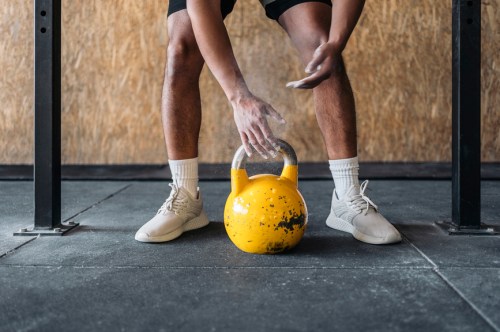I Started Breathing Correctly While Lifting Weights, and It Changed My Workouts in 3 Major Ways
Recently, I incorporated weight lifting breathing into my workouts, and discovered why it's so important to do correctly.

As a health and fitness writer, I often learn new info firsthand that ends up changing my own workouts. Recently, for instance, I wrote a story about the best way to breathe while lifting weights. Until then, breathing correctly hadn’t really crossed my mind during my workouts, even though I’ve started lifting more intensely in the last couple of months. But I’d interviewed the founder of the gym I go to, Global Strongman Gym in Brooklyn, and his words stuck with me.
Experts in This Article
personal trainer, award-winning competition strongman, and sport bodybuilder
“Breathing isn’t just good for lifting; it’s absolutely required,” owner Hans Pirman, a strongman, powerlifting, and bodybuilding coach, told me. Sure, you definitely get red in the face when you’re lifting heavy, but making sure to breathe in and out at the right time during your lifts can make a huge difference in your form, strength, and mentality.
Namely, Pirman told me that you should be inhaling as you wind up to do a lift, and exhaling as you exert. This looks like breathing deep as you prep for a deadlift and breathing out as you stand to support the lift. That strategy gives your muscles the oxygen they need to function, and also takes advantage of your diaphragm to support your core.
How breathing correctly while lifting weights improved my own workouts
I’ve known Pirman for awhile, and trust he knows what he’s talking about. So I decided to try what he recommended—and noticed three pretty major impacts on my workouts right away.
1. I could do more reps
I started my breath-focused workout with crunches on an incline bench. These are something I’ve done before and also do at home. Typically I have kind of a hard time with them, especially on the incline. I practiced inhaling on the extension (laying back on the bench) and then exhaling on exertion (doing the sit-up). I found that the exhale reinforced my abdominal muscles significantly, and I did 15 reps out of nowhere when I typically struggle to make it to eight reps in a set.
2. I could lift heavier
Although I didn’t anticipate lifting heavier, I was able to increase the weight on almost everything I did. Using the right breathing form made me feel a whole lot stronger. It’s wild to think about: It’s not like I went to sleep and built the muscle to increase my deadlift by 50 pounds overnight. Instead, it was a great lesson in how correct form can really show you just how much you’re capable of.
3. I felt more mentally centered
Sometimes a workout sucks, TBH. You don’t want to do it, or you feel tired from a whole day of being a person. I am not always in the best mindset when I arrive at the gym.
I also find lifting heavy weights to be emotionally difficult sometimes. Whether I’m testing out a new PR or going extra hard on a target area, I sometimes feel like the nervous emoji with its bead of sweat and worried expression. Other times I’m the red, sweating, exasperated emoji.
Something that surprised me about using proper breathing form was that focusing on that inhale helped me get mentally right before engaging in a heavy lift. That made a difference in my perceived fatigue (namely: not as much of it), how I felt about myself (stronger), and the workout itself (not nearly as anxiety-inducing).
It turns out, sometimes there are quick fixes in fitness. Now I just have to keep practicing until this whole breathing thing becomes a habit.
Sign Up for Our Daily Newsletter
Get all the latest in wellness, trends, food, fitness, beauty, and more delivered right to your inbox.
Got it, you've been added to our email list.










